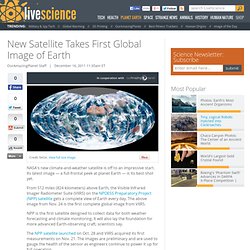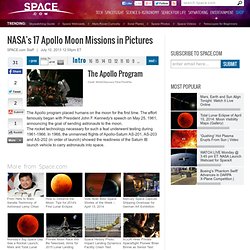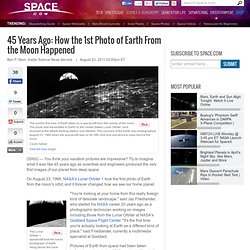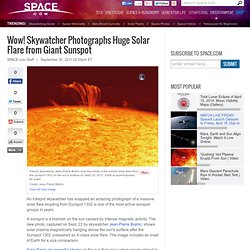

Infinity Imagined. Photos: Spectacular Comet Views from Earth and Space. New Satellite Takes First Global Image of Earth. NASA's new climate-and-weather satellite is off to an impressive start.

Its latest image — a full-frontal peek at planet Earth — is its best shot yet. From 512 miles (824 kilometers) above Earth, the Visible Infrared Imager Radiometer Suite (VIIRS) on the NPOESS Preparatory Project (NPP) satellite gets a complete view of Earth every day. The above image from Nov. 24 is the first complete global image from VIIRS. NPP is the first satellite designed to collect data for both weather forecasting and climate monitoring. It will also lay the foundation for more advanced Earth-observing craft, scientists say. The NPP satellite launched on Oct. 28 and VIIRS acquired its first measurements on Nov. 21.
Photos: Europa, Mysterious Icy Moon of Jupiter. Earth's Cities at Night: Photos From Space. 2011 Orionid Meteor Shower Photos by Skywatchers. Orion Constellation & Orion Nebula Photos. Astronomy Images & Satellite Imagery. NASA Kepler Spacecraft & Planet-Hunting Space Telescopes. Best Space Photos of the Week - Sept. 10, 2011. Earth From Space & Galaxies, Black Holes & Astronaut Photos. Best Space Photos of the Week: Aug. 20, 2011. Best Space Photos of the Week - Sept. 24, 2011. Gallery: Strange Nebula Shapes, What Do You See? How I Spent My Last Day In Space. Best Space Photos of the Week - Oct. 8, 2011. Artist’s Impression of The Dwarf Planet Eris. NASA's 17 Apollo Moon Missions in Pictures. SPACE.com Staff | July 10, 2013 12:59pm ET.

Amazing Photos: Titan, Saturn's Largest Moon. Surprising New 'Space Chicken' Photo Wows Astronomers. Astronomy Photos, Skywatching Views & Amateur Astronomy. 'Observe the Moon Night' to Light Up Skywatchers on Saturday. This weekend, the nearly full moon will to take center stage Saturday night for skywatchers around the world.
Photos: 65 All-Time Great Galaxy Hits. Total Eclipse of the Moon (Infographic) A penumbral lunar eclipse occurs Friday, Oct. 18, 2013.

See how to watch it live online here. A total lunar eclipse occurs when the moon passes completely beneath Earth's shadow. Solar System Exploration & Planet Definition. For three-quarters of a century, schoolkids learned that our solar system has nine planets: Mercury, Venus, Earth, Mars, Jupiter, Saturn, Uranus, Neptune and Pluto.

But things changed nearly five years ago today. Bright Star Cluster Shines in Tarantula Nebula's Shadow. Jupiter Probe Snaps Family Photo of Earth & Moon Together. A NASA probe headed to Jupiter has snapped a striking photo of Earth and the moon, showing our home planet as it appears from 6 million miles away.

The Juno spacecraft took the new photo on Aug. 26 as part of a test of its camera imaging system called JunoCam. The result: a parting shot of the Earth-moon system as the probe sails on its five-year trip to Jupiter. "This is a remarkable sight people get to see all too rarely," said Juno principal investigator Scott Bolton, of the Southwest Research Institute in San Antonio, in a statement.
"This view of our planet shows how Earth looks from the outside, illustrating a special perspective of our role and place in the universe. Crop Circles NASA-Style: 7 Huge Corn Mazes With Space Age Twist. Seven farms across the U.S., in collaboration with NASA, are inviting the public to get lost in space — the space inside crop circles — this fall. The "Space Farm 7" project is designed to celebrate the accomplishments of the U.S. space program through "agri-tourism.
" Take, for example, the Liberty Ridge Farm in Schaghticoke, N.Y., about 20 miles (32 kilometers) north of Albany. Astrophotography & Amateur Astronomy, Space Images. A delicate-looking cosmic bubble shape appears to float inside a distant nebula in this stunning view captured by California-based skywatcher Larry Van Vleet .

Solar System Storms & Saturn Rings And Moons. 45 Years Ago: How the 1st Photo of Earth From the Moon Happened. (ISNS) — You think your vacation pictures are impressive?

Try to imagine what it was like 45 years ago as scientists and engineers produced the very first images of our planet from deep space. On August 23, 1966, NASA's Lunar Orbiter 1 took the first photo of Earth from the moon's orbit, and it forever changed how we see our home planet. The Lunar Orbiter 1 spacecraft took the iconic photograph of Earth rising above the lunar surface in 1966. Credit: NASA. 50 Fabulous Deep-Space Nebula Photos. Giant in the Night Sky: Skywatcher Spots Colossal Pinwheel Galaxy. Equipped with an arsenal of telescopes and cameras, a French skywatching enthusiast had to venture beyond his suburban home in the so-called City of Lights to capture a brilliant deep night sky image of the Pinwheel Galaxy.
"I live in the suburbs of Paris, in a site that is very polluted by city lights," amateur astronomer Thierry Legault wrote on his website. "From my backyard, I can take images of the sun, the moon, planets and nebulas with narrow band filters. For night sky imaging (galaxies, comets, nebulas...), I am obliged to go in the land, after loading my van. " Spectacular Northern Lights Display Leaves Skywatchers Spellbound. A dazzling aurora light show amazed skywatchers across North America, from Canada to Arkansas, and other northern regions Monday night (Oct. 24), painting the sky with striking green and even rare red hues.

The aurora display, also known as the northern lights, was touched off by a wave charged particles unleashed by a massive sun storm on Saturday, which took two days to reach Earth, according to the Space Weather Prediction Center operated by the National Weather Service and NOAA. "These were the most vibrant I've ever seen," Canadian skywatcher Colin Chatfield of Saskatoon, Saskatchewan told SPACE.com in an email.
"I was also able to see red with the naked eye, which I've never seen before either. Simply put, they were amazing. " Canadian skywatcher Colin Chatfield caught this view of a stunning aurora display over his home in Saskatoon, Saskatchewan on Oct. 24, 2011. Skywatcher Snaps Mesmerizing Photo of Sun's Active Region. This stunning image shows a close-up look at an active region on the sun.

Taken of active region 1161-62 by Jean-Pierre Brahic in February 2011, the photo is a mesmerizing image of the energy flowing on our biggest star. Solar active regions are areas with an exceptionally strong magnetic field. They frequently host temporary dark patches on the sun called sunspots, and are often associated with solar flares and huge explosions of solar plasma called coronal mass ejections (CMEs) as well.
When Galaxies Collide: Photos of Great Galactic Crashes. Russian Federal Space Agency (Roscosmos) Skywatcher Photographs Huge Solar Flare from Giant Sunspot. An intrepid skywatcher has snapped an amazing photograph of a massive solar flare erupting from Sunspot 1302 is one of the most active sunspot groups in years.

A sunspot is a blemish on the sun caused by intense magnetic activity. The new photo, captured on Sept. 22 by skywatcher Jean-Pierre Brahic, shows solar plasma magnetically hanging above the sun's surface after the Sunspot 1302 unleashed an X-class solar flare. The image includes an inset of Earth for a size comparison. Solar flares are powerful storms on the sun that occur when energy stored in twisted magnetic fields (usually above sunspots) is suddenly released.
Flares produce a burst of radiation from radio waves to X-rays and gamma-rays. Spellbinding Photos:The Dazzling Auroras of October 2011. Extrasolar Worlds, Exoplanets & Science Fiction, George Lucas. Spectacular Photos of Monster Saturn Storm Snapped by NASA Spacecraft. A NASA spacecraft has chronicled the birth, evolution and death of the biggest storm to hit Saturn in two decades. The monster storm on Saturn emerged in the ringed planet's northern hemisphere on Dec. 5, 2010. It started out as a tiny spot but grew rapidly, completely encircling the planet by late January 2011. It eventually extended about 9,000 miles (15,000 kilometers) from north to south before sputtering out in late June. The storm's 200-day active period makes it the longest-lived planet-encircling tempest ever observed on Saturn, researchers said. And NASA's unmanned Cassini probe watched everything unfold, snapping pictures all the while.
Sands of Mars Caught Blowing in the Wind by NASA Spacecraft. A powerful NASA spacecraft has spotted shifting sand dunes and ripples all over Mars, with strong Martian winds keeping the sandy Martian surface much more active than scientists ever imagined. The new images from the Mars Reconnaissance Orbiter show wind-blown sand dunes moving across the Martian surface, sometimes up to several yards at a time, scientists said.